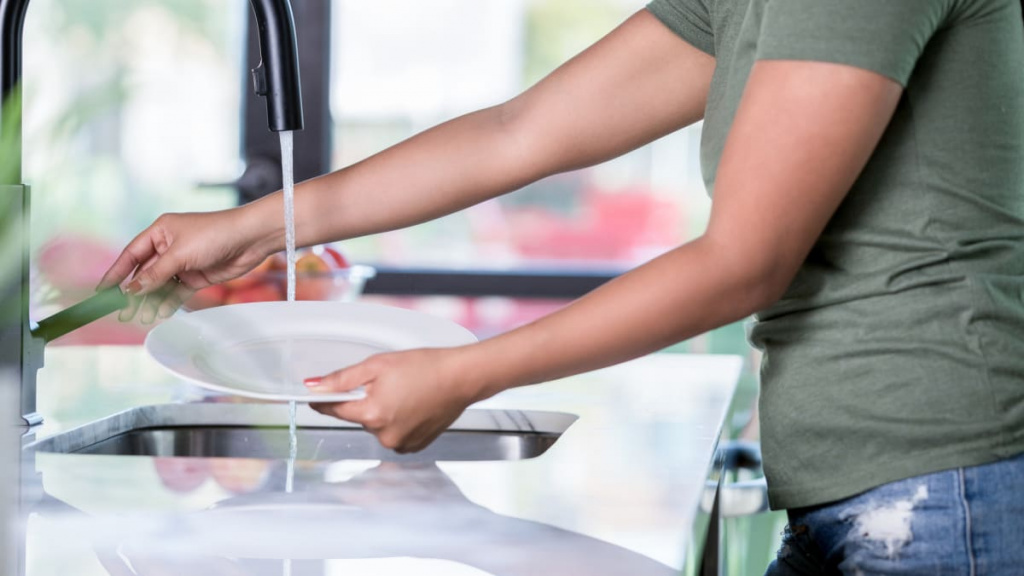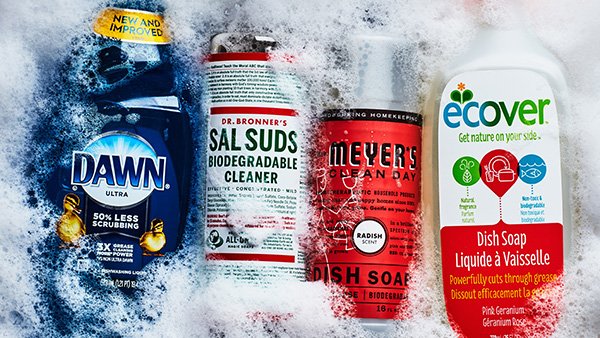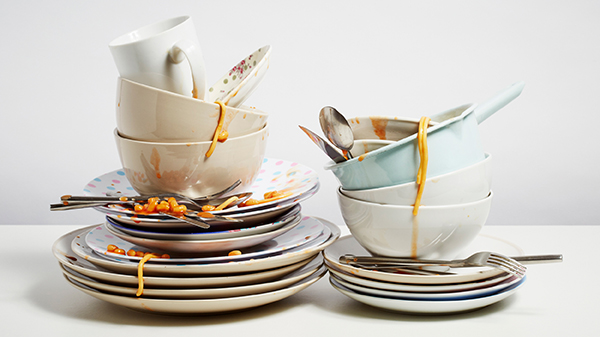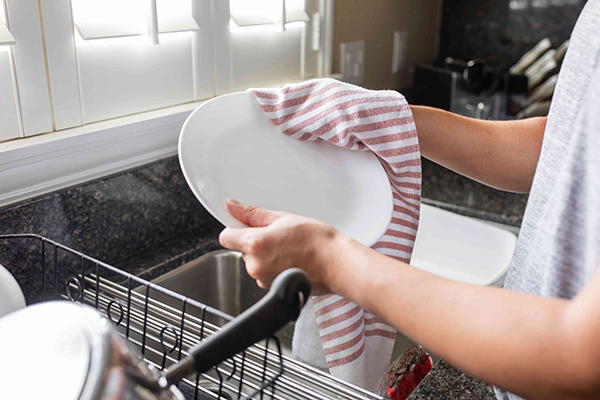
How to quickly wash dishes
Today we will tell you how to turn washing dishes into an exciting quest from a boring routine process. You will learn how to wash a mountain of dishes in 10 minutes and many interesting subtleties of this process.
After our article, you will become an expert on clean dishes and schedule your dishwashing so you don’t miss your turn. And to begin with, we will choose the right tools and means

Dishwashing liquids
These accessories will make the process of washing dirty dishes easy and fun. Soon you will become experts in various household items and learn how to choose high-quality detergents.
We will need:
-
sponge;
-
brush;
-
dishwashing liquid;
-
napkins;
-
special devices;
Let’s take a look at which of these tools are the most effective.
Sponges
This product is most often used in the household. Sponges made of foam rubber differ in several ways:
-
To size. There are small, medium and large specimens. The choice should be stopped on the one that is most comfortable for the hand. -
According to the porosity of the material. The size of the pores is of no fundamental importance. With large pores, the foam is more voluminous, due to the size of the soap bubbles. Dense foam from finely porous foam rubber contains a high concentration of surfactants. This contributes to the rapid breakdown of fatty and other contaminants. -
By softness. The soft material has less cleaning power, but is more gentle on delicate surfaces. -
By the presence of abrasive fiber or other coating. The presence of additional elements in the form of a metallized mesh, a fiber layer increases the efficiency of cleaning complex contaminants. -
By price. This parameter is often not decisive. The price depends on the brand, the cost of materials and equipment on which the goods are produced.
We recommend choosing a medium-pored sponge, the size of your palm, with a layer of abrasive fiber applied. You should also be guided by your own needs and choose the best option for the price. Gradually having tested in practice different types of foam rubber products, you can choose the copy that is right for you.
Ershiki and brushes

Other types of dishes for washing dishes include various brushes, brushes, scrapers. Such things often have ergonomic handles, they are comfortable to hold. Also, cleaning devices have the following advantages:
-
Efficient cleaning of dirt due to the increase in the cleaning surface of the device. If we hold an ordinary sponge in our hand so that we use only part of the product. In this case, we wash the entire surface area of the brush evenly distributing the pressure of the hand thanks to the handle.
-
Fast cleaning of hard-to-reach places. The bristles easily penetrate and remove deposits and deposits in the recesses near the handles.
-
Keeping the softness of the hands. Dryness and irritation of the skin occurs due to the action of aggressive components of detergents. Abrasive coatings of sponges cause micro-scratches, which leads to roughness of the skin of the hands. The use of brushes with handles eliminates direct contact with detergents.
-
Reducing the consumption of detergents. Due to the large cleaning capacity, the need for excessive use of surfactants is significantly reduced.
-
Ease of storage. Thanks to the handles, the brushes can be hung or placed in a stand. Natural ventilation of the washing surface reduces the rate of bacterial growth.
Frequency of replacement of mechanical devices
Auxiliary cleaning household items are consumable items that must be replaced periodically. Like any thing, sponges and brushes wear out and fail over time:
-
The spongy layer is crushed, torn.
-
Abrasive fiber becomes thinner and rolls.
-
The bristle is deformed and crumpled.
In addition, organic residues penetrate into the thickness of the material and between the bristles, which provoke the growth of bacteria and fungi. Infected objects are a source of spread of fungal spores and bacteria (often pathogenic). Therefore, we recommend excluding the use of contaminated children’s dishes.
Consumables must be replaced in a timely manner. In the case of a daily active struggle for the cleanliness of dishes, sponges physically cannot stand the constant load. Therefore, they will simply need to be replaced after 1-2 weeks.
At the same time, use common sense. If you wash 1 plate a day, then you can postpone the replacement of the foam assistant by 1 month.
In the event that the sponge looks quite fresh and the hand does not rise to throw it away, transfer it to the category of cleaning supplies.
Also, in order to save money, we can advise you to send washcloths to the dishwasher once every couple of days. We do not recommend putting foam rubber in a microwave oven, because when heated strongly, synthetic materials transform and release toxic substances.
Wipe wipes
On this issue, the fighters for cleanliness are divided into 2 camps. Some meticulously wipe all the washed dishes. Others just let the water drain and put the kitchen utensils in their places. But one moment unites 2 opposing camps. It is crystal and glass.
As soon as the glasses begin to dry, whitish stains immediately become visible on them. Therefore, even the most notorious opponent of wiping dishes will definitely take a napkin and rub a crystal glass to a shine.
To do this, choose the right textile. The main characteristics and models of napkins corresponding to the description are presented in the table:
|
|
|
|
|
Hygroscopicity
|
Ability to absorb water
|
Microfiber, terry cloth, waffle cloth, cellulose, viscose, bamboo cloths
|
|
hydrophilicity
|
Ability to hold large amounts of water
|
Microfiber, cellulose
|
|
Dirt-repellent properties
|
Characterize the ease of washing
|
Microfiber, bamboo cloths
|
|
Drying speed
|
The ability to quickly release moisture allows frequent use of textiles and reduces the risk of decay and bacterial growth
|
Microfiber, bamboo cloths
|
|
Delicate care
|
Do not leave dust and lint after wiping
|
Microfiber, bamboo, viscose
|
Detergents

Household chemicals do an excellent job. The hostesses are satisfied with the time savings and the cleanliness of the washed dishes. Another issue is the environmental friendliness of the selected products. Some fluids are made from natural ingredients, while others are purely synthetic.
We present you the most effective dishwashing detergents.
Ecosoda
Natural product based on glycerin and natural oils. Contains soda and active substances that are washed off when rinsing. Glycerin softens the skin of the hands. Biosilver ions have an antibacterial effect and inhibit the growth of microorganisms.
Bio Mio
The natural composition allows you to safely use the product for washing dishes, fruits, children’s supplies for feeding and playing. The concentrated composition provides an economical consumption.
Sinergetic
The composition has hypoallergenic and antibacterial properties. Effectively washes away dirt at any water temperature. Recommended for washing children’s things, dishes and fruits.
Pril
A concentrated product based on active synthetic substances with the addition of natural caring ingredients. Aloe extract and vitamin E soften and protect the skin of the hands.
Pril works in a wide temperature range, effectively washes various types of dirt, even on a relief surface.
Sanita
The composition of the thick gel includes artificial active substances, dyes and fragrances, which copes well with pollution and does not dry the skin of the hands. The product lathers well and washes away grease even in cold water. Recommended for washing dishes and kitchen surfaces.
Sarma soda effect
Due to the thick gel-like consistency, the liquid foams well, washes away complex contaminants in cold water. Contains substances that prevent the growth of bacteria. The composition includes soda and other active chemicals.
How to wash a mountain of dishes in 10 minutes
To begin with, take an evaluative look at the upcoming work and determine the main groups of dishes. It can be:
-
Wine glasses, glasses, cups.
-
Plates, saucers.
-
Forks, spoons, knives.
-
Frying pans, pots.
-
Other plastic and metal items: containers, spatulas, vegetable peelers.
Today, our goal is not to clean the dishes from soot, complex dirt and stains, but to quickly deal with a large amount of miscellaneous porcelain, metal and plastic.
Imagine that all our dirty dishes are on the table, and we ourselves can determine in what order we will wash them.
Using this dishwashing technique, we kill 3 birds with one stone: we save time, water and detergents.
We will prepare strategic equipment in the form of sponges, brushes and detergents and will act according to the instructions.
Training

Before washing, remove the leftover food from the dishes, put them in piles, sort them into groups and proceed:
-
Wear gloves if your skin is dry and sensitive.
-
Close the hole in the kitchen sink with a stopper and fill with warm water. An alternative option is to pour water into a basin.
-
Drop a few drops of detergent and stir in water. Or pour the product under running water to create lather.
-
If you have a double sink, fill the other half with clean water. If not, then pour water into the second basin.
Washing process
Let’s start with the cleanest (not greasy) dishes. We put glasses and similar glass and ceramic products, including tea saucers, into the soapy solution.
Why don’t we put all the dishes at the same time? If you put greasy plates along with crystal wine glasses, the water will instantly become contaminated. Under the influence of warm water, the fat will melt, float, cover the surface of the water and wine glasses with a thin film. You will have to spend extra detergent or change the water.
Therefore, the most reasonable thing is to rinse the practically clean glass using a clean sponge and lather of the solution in the sink.
Next is the turn of the remaining dishes. You can put everything in the water that will fit. Washing is also more convenient in groups.
First of all, let’s wash the plates. Then cutlery. They can be washed in batches. To do this, take the forks and spoons in one hand, open them with a fan, and rinse the appliances alternately from 2 sides with a sponge.
Do not forget that we send all the dishes for rinsing in a nearby container.
When there is room in the sink again, put the pots in the water. Greasy pans will wait a bit. But in order not to waste time, put a drop of Fairy into the pans and pour warm water. Let them get wet.
In the meantime, wash pots, plastic containers, lids, ladles and spatulas.
The next step is to load the soaked pans and finish the washing process on them. Dirty pans will require additional use of dishwashing liquid.
Rinsing
If the issue of saving water is not so critical, we offer the following option for rinsing homemade porcelain and ceramics. We rinse the dishes folded into the sink, but do not take them out, but drain the water.
Next, turn on the running water, rinse each device in turn and set it to drain either on a towel or on a special dryer.
Draining water from a basin filled with dishes is problematic. In this case, we do this:
-
We rinse all the dishes one by one, put it on the table.
-
We change the water and again load all the kitchen utensils into the basin.
-
Rinse, take out and leave to drain.
-
You can repeat the procedure again.
Rubbing

This stage is not for everyone. We will not impose the process as necessary. You need to approach the situation individually. If there is not enough time, it is enough to let the water drain. Next, arrange the dishes in their places.
Useful life hacks
Actions that do not require a lot of time and effort will help to avoid the accumulation of dishes and save time on washing them. Here are some tips to help optimize your dishwashing process:
-
In the morning after breakfast, place the plate and cup in the sink and fill with water. Put cutlery on a plate so that they are also in the water. While you are preparing, the dishes will get soaked and it will be enough for you to simply rinse them and leave them on the dryer.
-
After a family dinner, put the dishes in the sink, pour water with a few drops of liquid detergent and leave for 20-30 minutes.
-
If you are on a camping trip and you forgot your soap, take the ashes from the fire and use them as a cleaning agent. It also cleans greasy dishes with sand and horsetail greens.
-
When washing a service covered with glaze, do not use an abrasive, in order to avoid damaging the surface.
-
Wash glass and crystal by hand, rinse with cold water and wipe with a napkin.
-
After washing, put the glasses to drain upside down, and hang the wine glasses by the leg. This will avoid water stains.
The little tricks and tricks we have proposed will save time on washing dishes. And in emergencies, such as a dinner party or a party, knowing how to quickly wash, you can easily cope with a mountain of china and glass.
Добавить комментарий
Для отправки комментария вам необходимо авторизоваться.